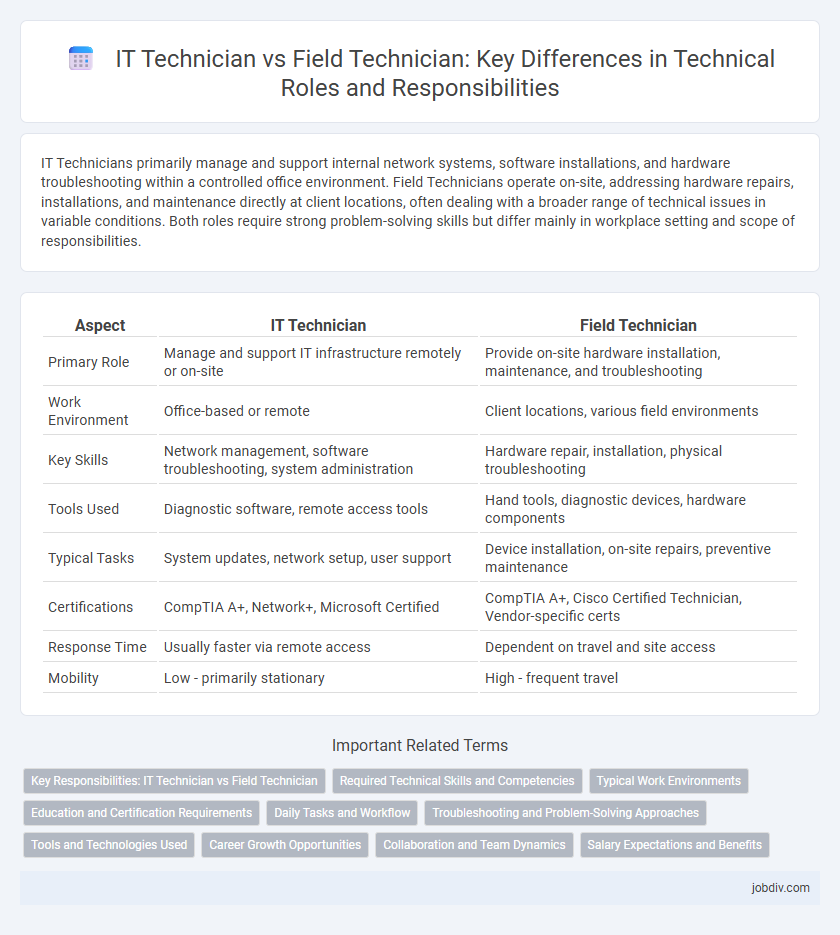IT Technicians primarily manage and support internal network systems, software installations, and hardware troubleshooting within a controlled office environment. Field Technicians operate on-site, addressing hardware repairs, installations, and maintenance directly at client locations, often dealing with a broader range of technical issues in variable conditions. Both roles require strong problem-solving skills but differ mainly in workplace setting and scope of responsibilities.
Table of Comparison
| Aspect | IT Technician | Field Technician |
|---|---|---|
| Primary Role | Manage and support IT infrastructure remotely or on-site | Provide on-site hardware installation, maintenance, and troubleshooting |
| Work Environment | Office-based or remote | Client locations, various field environments |
| Key Skills | Network management, software troubleshooting, system administration | Hardware repair, installation, physical troubleshooting |
| Tools Used | Diagnostic software, remote access tools | Hand tools, diagnostic devices, hardware components |
| Typical Tasks | System updates, network setup, user support | Device installation, on-site repairs, preventive maintenance |
| Certifications | CompTIA A+, Network+, Microsoft Certified | CompTIA A+, Cisco Certified Technician, Vendor-specific certs |
| Response Time | Usually faster via remote access | Dependent on travel and site access |
| Mobility | Low - primarily stationary | High - frequent travel |
Key Responsibilities: IT Technician vs Field Technician
IT Technicians primarily troubleshoot hardware and software issues, manage network configurations, and maintain system security within office environments. Field Technicians specialize in on-site support, installation, and repair of equipment, often working directly with clients to resolve technical problems in various locations. Both roles require strong diagnostic skills, but Field Technicians emphasize mobility and hands-on service delivery, while IT Technicians focus on centralized IT infrastructure management.
Required Technical Skills and Competencies
IT Technicians require strong knowledge of network infrastructure, system administration, and software troubleshooting to manage and support internal IT environments effectively. Field Technicians must possess hands-on skills in hardware repair, on-site diagnostics, and customer-facing communication to resolve technical issues directly at client locations. Proficiency in remote support tools and adaptability to varied hardware configurations distinguishes IT Technicians, while Field Technicians need expertise in physical installation and maintenance of equipment in diverse environments.
Typical Work Environments
IT Technicians primarily operate within office settings, data centers, and server rooms where they manage hardware and software configurations, troubleshoot networks, and maintain cybersecurity protocols. Field Technicians work on-site at client locations, including industrial plants, retail stores, and residential areas, handling installations, repairs, and system upgrades in diverse and often unpredictable environments. Both roles require adaptability, but Field Technicians face varying conditions such as outdoor weather and complex facility layouts, contrasting with the controlled environments typical for IT Technicians.
Education and Certification Requirements
IT Technicians typically require a foundational education such as an associate degree in information technology or computer science, often supplemented with certifications like CompTIA A+ or Microsoft Certified Solutions Associate (MCSA). Field Technicians usually need similar educational backgrounds but prioritize certifications emphasizing hardware and network troubleshooting, such as Cisco Certified Network Associate (CCNA) or CompTIA Network+. Both roles benefit from ongoing training and vendor-specific certifications to stay current with evolving technologies.
Daily Tasks and Workflow
IT Technicians primarily manage internal system maintenance, software updates, and network troubleshooting within a centralized office environment, ensuring seamless IT operations and minimizing downtime. Field Technicians engage directly at client sites, performing hardware installations, on-site repairs, and real-time diagnostics, often adapting to diverse environments and urgent technical issues. Daily workflows for IT Technicians emphasize remote monitoring and system optimization, while Field Technicians prioritize mobility, customer interaction, and immediate problem resolution.
Troubleshooting and Problem-Solving Approaches
IT Technicians primarily utilize software-based tools and remote diagnostic applications to troubleshoot network issues, system errors, and hardware malfunctions, emphasizing rapid problem resolution via digital interfaces. Field Technicians rely on hands-on inspection and physical manipulation of equipment on-site, employing specialized diagnostic devices to identify and repair faults directly within client environments. Both roles demand strong analytical skills, but IT Technicians prioritize virtual troubleshooting platforms, while Field Technicians focus on practical problem-solving techniques involving hardware components and on-location conditions.
Tools and Technologies Used
IT Technicians primarily utilize software diagnostic tools, network analyzers, and remote access applications to troubleshoot and resolve system issues within office environments. Field Technicians rely on portable hardware testers, cable fault locators, and handheld devices to perform on-site repairs and installations in diverse locations. Both roles require proficiency with ticketing systems and knowledge of operating systems such as Windows, Linux, and macOS to efficiently manage technical support tasks.
Career Growth Opportunities
IT Technicians often have broader career growth opportunities in network administration, cybersecurity, and systems engineering due to their expertise in managing internal IT infrastructure. Field Technicians specialize in on-site hardware repair and customer support, which can lead to careers in technical sales, system installations, or field service management. Both roles offer distinct pathways, but IT Technicians typically have more avenues for advancing into strategic IT roles.
Collaboration and Team Dynamics
IT technicians and field technicians collaborate by integrating remote support with on-site problem resolution to enhance overall service efficiency and minimize downtime. Seamless communication between these roles ensures quick diagnostic information exchange, enabling faster troubleshooting and repair processes. Effective team dynamics rely on mutual understanding of technical expertise and coordinated task execution to optimize client satisfaction and operational productivity.
Salary Expectations and Benefits
IT Technicians typically earn an average salary ranging from $45,000 to $65,000 annually, with benefits including health insurance, retirement plans, and professional development opportunities. Field Technicians often command higher salaries between $50,000 and $70,000 due to travel requirements and on-site problem-solving skills, accompanied by benefits such as travel reimbursements, flexible schedules, and safety allowances. Salary expectations for both roles are influenced by industry demand, certification levels, and geographic location, with Field Technicians generally receiving premium compensation for fieldwork and physical labor.
IT Technician vs Field Technician Infographic

 jobdiv.com
jobdiv.com